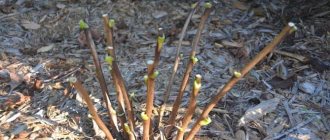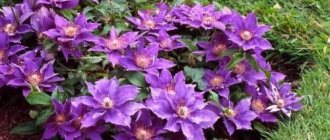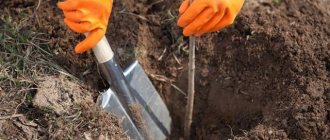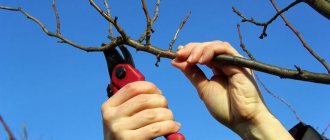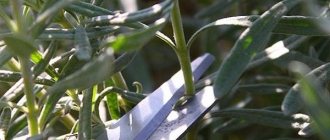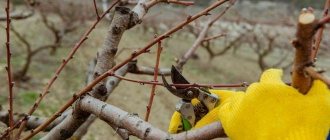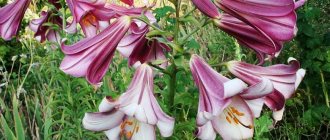Should you rush to trim and cover peonies for the winter? How will this affect the health and further flowering of the bush? Herbaceous peonies and Ito hybrids are prepared for overwintering differently than tree peonies. The above-ground part of herbaceous peonies dies off by winter, but the plant continues to live. Our task is to create optimal conditions for its preservation.
In dry autumn, it is possible to cut off the peony stems as they die
Timing for pruning herbaceous peonies
The herbaceous peony is a perennial flowering plant whose shoots and leaves die off in the fall. In some bushes the above-ground part turns yellow and lies down, in others it dries up, maintaining a vertical position for some time. Only then do I start pruning. Of course, we are talking about healthy, not sick peonies.
The shoot of a young herbaceous peony wilted after the first autumn frost
The time to trim the stems of herbaceous peonies depends on specific climatic conditions. This is either the end of September or the beginning of November, it all depends on the weather. There were years when rivers froze and snowdrifts appeared in the Moscow region in early October. In other years, primroses and honeysuckle bloomed again in November. In mid-October 2021, our lilac bushes tried to bloom. The average time for pruning herbaceous peonies is mid-October, if there have been no frosts before.
Early pruning . In herbaceous peonies, two waves of root formation are observed: spring (April-May) and summer-autumn (August-September). Consequently, pruning too early (in early September) does not allow the rhizome to accumulate nutrients coming from the foliage. This leaves the weakened perennial plant vulnerable in winter. Such a plant will bloom worse. Premature autumn pruning shortens the period of preparation of the peony for wintering.
You can clearly see what early pruning and warming of a herbaceous peony bush leads to during a long, rainy autumn.
Late pruning . Another danger lies in wait for a peony when pruning the above-ground part of the bush is belated. Especially in cold, rainy autumn, when dried stems and leaves quickly rot. This can cause damage to the rhizome.
When pruning, I leave short (2-3 cm) stumps. They will mark the place where the bush grows, protect the buds, but will not interfere with the spring growth of shoots.
After pruning, I collect all plant debris with my hands, and then superficially loosen the soil around the bush and remove weeds.
Peony pruning technology
We decided on the timing of pruning absolutely and unconditionally. Before you begin the procedure itself, you need to figure out how to properly prune peonies for the winter so as not to accidentally harm them. Some nuances should be taken into account, namely:
- After flowering, but before pruning, the bushes should be fed with organic fertilizers - a solution of bird droppings or mullein. They have the same effect: they promote the formation of new buds and strengthen the roots.
- When pruning, almost the entire above-ground part is removed, including all leaves, flowers and stems.
- Small stems above the buds, from 3 to 5 cm in length, should be left. You can leave a different length, the one that will be convenient for you.
- You only need to trim with sharp pruning shears so as not to damage the stems protruding above the ground.
- Places of cuts and the soil itself near the bush should be sprinkled with wood ash. It disinfects and nourishes the soil well when pruning peonies for the winter is completed.
After pruning, all plant debris should be removed from the flowerbed and burned to prevent pests, although peonies are not picky about care and have good immunity to various diseases and parasitic microorganisms. Some gardeners make a big mistake by leaving leaves for cover for the winter. This should not be done, as this can cause rotting, which will lead to the formation of fungus and attract pests.
Dry peat, sawdust, spruce branches, fallen leaves or humus should be used as covering material. They will warm the peony much better during frosts and reliably protect it from pests. When forming a shelter, it is necessary to create a protective layer of 10-15 cm.
It is worth noting that the pruning method described above is only suitable for herbaceous varieties. It is best to prune tree peonies in the spring, namely in April. At this time, all broken branches and dry leaves are removed. These varieties of flowers do not like autumn pruning, as they cannot tolerate frequent removal of branches. But if you suddenly find damaged or diseased shoots, you can carry out sanitary pruning.
You may be interested in: Peony Ito hybrid Bartzell: planting and care
Peony care after pruning
After pruning, be sure to check how moist the soil is in the cut areas. If it is dry, then you need to water and feed the bushes properly. The following fertilizers should be applied in the fall:
- bone meal (200 g per bush);
- wood ash (300 g per bush);
- ready-made mineral fertilizers that do not contain nitrogen.
Before feeding the bushes, be sure to read the instructions for using fertilizers. Trimming peonies is very simple, however, despite this, many summer residents still manage to make the following mistakes:
- Peonies are pruned immediately after flowering, around the end of summer. The bush manages to grow new shoots, spending a lot of effort on their growth. But at the first frost they will die, and the bush will not have enough nutrients for the development of the bulb. As a result, in spring you may not wait for flowers at all.
- Cut off flowering inflorescences. Usually the flowers are cut to make bouquets. This, of course, is good, but the bouquet will please the eye for only a short time, but next year the number of inflorescences will obviously decrease.
- Postpone pruning until spring. In this case, the plant will not have time to renew its root system, which may subsequently rot.
To summarize, I would like to note that we have dealt with this part of preparing peony bushes for winter. Autumn pruning is really necessary and mandatory. Moreover, you need to cut everything without regret. The procedure is easy and not labor-intensive, there is nothing complicated about it. There is only one thing to follow, but the most important rule is to prune at a certain time, that is, at the end of October and beginning of November. Abundantly flowering and lush peony bushes can decorate any area. To do this, you just need to carry out all the simple steps to care for them.
Winter shelter for herbaceous peonies
Zoned herbaceous peonies can withstand winter hardships, but they still need to be covered for the winter. Without this, during the frosty, snowless period, renewal buds and parts of the rhizome are likely to freeze. In open areas, strong winds sweep away snow, leaving the ground “black.” Mulching the soil to a height of at least 10 cm reduces the risk of freezing.
In autumn there is often rain and sleet. When covering a herbaceous peony with insufficiently rotted manure or undecomposed grass and leaves, the stumps of the stems and rhizomes may rot.
I insulate my peonies with a mixture of high-moor peat with neutral acidity, sand and earth. I buy deoxidized peat in large orange packages at the nearest garden centers. You can get by with well-decomposed crumbly compost or loose garden soil. The approximate volume is a bucket of 8 - 10 liters for each herbaceous peony bush.
Before covering the growing area of an adult peony with soil mixture, I pour a shovelful of sand onto the ground. For young bushes, one scoop is enough. Such a sand layer is useful not only for bulbous perennials, but also for many rhizomatous perennials. It is not worth insulating peonies with sand alone, because... it doesn't hold heat well.
Tree peonies: preparing for winter
The most work to prepare for wintering will be with tree peonies.
tree peony after the first snow
Autumn feeding of tree peonies
Everything here is the same as in previous cases.
Winter shelter for tree peonies
Preparing tree peonies for winter is more similar to preparing climbing roses for winter than regular peonies.
In October, after the onset of stable autumn cold, the leaves of tree peonies are removed (the branches are not cut, but the foliage is removed). Then, carefully, so as not to break the shoots, the peony is tied. You should not bend the shoots of tree peony to the ground; they are very fragile and can easily break.
When the first light frosts arrive, a hut is built around the peony. You can make it from branches of spruce branches or from any available material.
Lutrasil with a density of 60 g/m2 is stretched onto the frame from above. Sometimes it is recommended to use burlap, but it can become covered with ice during thaws and frosts, which practically does not happen with non-woven covering materials.
When to remove cover from tree peonies?
At the same time as with roses and grapes. All these heat-loving crops require approximately the same wintering conditions. In March, the shelters begin to be ventilated, in April they are removed. It is better to focus not on dates, but on weather conditions. For example, the winter of 2019/2020 was such that many people removed their shelters already in March!
Ito hybrids of peonies
Some gardeners grow and bloom Ito hybrids of mid-late varieties. Early varieties are less common. When pruning these perennials, a number of features must be taken into account. Strong bushes are not afraid of autumn frosts. In autumn, their foliage, similar to the leaves of tree peonies, turns into bright colors, decorating the empty area. It often lasts until the first snow.
Ito hybrids are pruned at a later date than herbaceous ones. When pruning Ito hybrids, take into account that some of the numerous renewal buds are on the stem, and some are on the roots. Some of them sit close to soil level. When removing shoots, leave small stumps (like herbaceous peonies) or cut them off completely. Aboveground buds do not need to be protected: in the spring, new flowering shoots will rise from the underground buds. It is important not to damage the tips of the root buds of renewal.
There is another pruning option, in which you select two or three of the strongest stems with several large buds closer to the base. These stems need to be cut at a height of 10 - 20 cm. Pruning must be carried out in dry weather. After this they are insulated. The easiest way is to use wooden boxes, the inside of which is stuffed with shavings or non-woven material. It is better not to take hay and straw so as not to attract mice. You can wrap the shoots in lutrasil and build a hut over them from spruce branches. The cover is removed when the primroses begin to bloom. When it gets colder, use lutrasil or other lightweight material. With this pruning option, flowering of Ito hybrids occurs a couple of weeks earlier than with complete removal of the entire above-ground part in the fall.
Adult bushes of Ito hybrids are quite winter-hardy. However, it is worth covering them for the winter, at least for the sake of insurance in case of a harsh winter with little snow. The mulching area should be such that the bulk of the roots, located in a horizontal plane, are under the insulation. The soil mixture should not increase the acidity of the soil, so it is better to add wood ash to peat or compost.
How to prune peonies in the fall?
Peonies need to be trimmed in two stages:
- The first involves pruning wilted flower stalks. There is no need to remove leaves to continue accumulating useful elements through photosynthesis.
- The second stage is complete removal. The plant itself will help determine the period. By the right time it will completely sink to the ground.
Trimming technology
As soon as the time has come, the wilted bushes are removed by cutting them with pruning shears. Don’t forget to treat the instrument with alcohol to sterilize it.
It is better to trim the stems by following the sequence of actions:
- Prepare a sharpened pruner.
- Cut off the entire above-ground part of the bushes. All stems along with foliage can be removed.
- Sometimes, if necessary, the pruning shears should be driven deeper into the soil to cut off “empty” shoots.
- Leave stems with growth buds at a level of up to 5 cm.
- It is recommended to put all cut parts into a compost pit and burn them. Under no circumstances should you leave them, much less wrap the plant for the winter. This may attract rodents and vermin.
In a tree-like variety, the above-ground part is removed in mid-spring in the form of sanitary pruning. Weak or dry shoots are removed, forming bushes every 3-4 years, also by pruning.
Therefore, the technology of tree and herbaceous species is different. The described sequence of actions and timing apply only to herbaceous peonies.
Trimming errors
Trimming peony stems in the fall is easy.
But despite the ease of the procedure, many make typical mistakes:
- Early removal in summer. Before winter, the bushes will put out young stems, which will require a lot of effort. The shoots will die at the end of autumn, when frosts occur. The bulb will not fully develop.
- Late pruning will cause root rot.
- Some inexperienced gardeners prune flowering plants. This also cannot be done.
- Perform the procedure in the rain. To prevent the development of fungus, the circumcision procedure should be performed exclusively in dry weather.
What to do if peony...?
Sick during the summer
The most common cause of peony diseases is too acidic soil. In this case, before autumn mulching, add dolomite (dolomite flour at the rate of no more than 0.5 kg per 1 m2) to the soil to deoxidize the soil.
Burn the diseased leaves and treat the bushes with a 1% solution of Bordeaux mixture.
cut off the diseased peony leaves and burn them at the fire of the Inquisition
Attempts to achieve a yellow color by crossing herbaceous peonies
Until 1948, active selection was carried out all over the world and largely unsuccessful attempts to obtain varieties with a yellow color continued without drastic measures. As a result of selection based on the large-leaved peony, Mlokosevich and Vitman, which by nature partially have the yellow flavone pigment, modest varieties were obtained that only had individual yellow details.
During this period, the greatest contribution to the hybridization of peonies was made by Earl White, who obtained the first of the conditionally yellow varieties, “Claire de Lune,” in which the yellow pigment appeared so weakly that it only gave the flower shades of cream and ivory.
Ballerina , White Sands, which are still in great demand today ). White Sands), Cheddar Cheese, Golden Bracelet , Moon , etc.).
Peonies – video
Planting peonies
If you filled the pit correctly, put in the required amount of fertilizer - organic and mineral fertilizers, dolomite flour, ash, potassium, phosphorus, then you will have enough food for five years. For five years! The roots will reach the food and they will have enough. For five years it will be possible not to feed peonies, and after five years we begin to return to feeding. We feed with mineral fertilizer before budding: the Kemira complex, for example, and after flowering it is necessary to feed with potassium-phosphorus fertilizer, without nitrogen. The books say that peonies need 4 feedings. You can do four or even more, but it’s not worth it. We all kind of strive to be weekend gardeners, as Karl Capek said: “Be lazy gardeners.”
This means that the first feeding of the peony before flowering is mainly with a complex fertilizer containing phosphorus, nitrogen, and potassium. The ratio of batteries is approximately the same. We carry out the second feeding after flowering, somewhere in mid-July - we add soluble phosphorus-potassium fertilizer, because at this time the buds are being laid, which will ensure flowering next year.
Peonies are a royal flower and should be treated like royalty. It requires very thorough planting in order to receive royal flowers. Planting peonies is like planting a tree. It's something like this: the planting hole should be at least 50 by 50 centimeters. 50 - in width and 50 - in depth, which is 3/4 filled with nutritious soil - nutrient soil, and about one quarter is garden soil in which we plant the peony. What can be added as nutrients to a peony pit? You can add well-prepared leaf humus, garden humus, compost, well-rotted manure, and very well - horse manure. But this is manure that has been sitting for at least a year. Horse manure can be fresh. Peony loves horse manure very much. Mix it all up. Add mineral water: there is a lot of dolomite flour. A lot is about 400 grams per planting hole. This is for the Moscow region, because here the soil is slightly acidic and acidic, so it is best to add peonies. And 3/4 of the planting hole was filled with this nutrient mixture. Then they took clean garden soil. the one in the garden. They poured a small layer, laid a section and covered it with clean garden soil.
Watering peonies
Peonies should be watered throughout the growing season, avoiding the accumulation of moisture in the roots. It is better to water less often, but more abundantly. It is not recommended to use cold water from a well for watering flowers; it is better to warm it up in the sun for a while. One peony bush needs at least 10 liters of water per watering, and preferably 3-4 buckets, depending on the size of the plant. In hot weather, make sure that an earthen crust does not form after watering; to do this, regularly loosen the soil around the bush.
Peony diseases
It is better to prevent any disease than to treat it. What can be used as preventive measures? Well, the main disease of peonies is botrytis (gray rot). It begins when the edges of the leaves begin to dry out, turn brown, and develop spots. The danger is that this disease develops further, and it penetrates through the stem into the roots. The cause of botrytis is waterlogging. This could be dampness, fog, or prolonged rain. If, for example, it gets cold, it starts raining - wait.
What to do to prevent? It is necessary to carry out antifungal and antibacterial treatment from early spring. For example, copper preparations: “Hom”, “Oxychom”, Bordeaux mixture and copper sulfate. But this also should not be abused, because copper preparations still disturb the environment. Incl. accumulate in the ground, so we use softer products like Fitosporin. Well, if a peony gets sick, then, of course, you need to use copper preparations. How much per season can peonies be treated prophylactically and is it necessary? Well, 2-3 times. That is, in the spring, then somewhere in the middle of summer. If the disease appears, then, of course, it needs to be treated thoroughly. Sometimes one “Fitosporin” helps. Apart from botrytis, other diseases are rare. It practically never happens. There are, of course, tobacco ring mosaics, and there are also nematodes, but very rarely.
The question is with the ants that are crawling here, crawling. What to do with them, poison them? Yes, ants really bother peony owners. Many people think that they eat peonies - no. Or, for example, they carry aphids. Well, like aphids, they are not on peonies. We didn't notice her. Ants feed on the nectar that appears on the buds. They don't eat peonies. That's why we don't look at them, let them eat until they're full. Bronze beetles also love them. When the flower opens, they crawl under the petals. Well, if you remove it, another one will appear. Some people write that my bronzes periodically eat up all my peonies. This is a possible option when there are a lot of them. That is, if there was one bronze, then they admired it, and if there was more, they simply shook it off. And she came again. Well, when peonies bloom, you can’t spray them with anything. You won't be able to destroy all the bronzes. They will arrive 3-4 kilometers away. That is, basically the fight is only manual. We shake it off, collect it and take it to another area. Let the owners there, too, eventually admire these little bronzes.
Ito hybrids of peonies
The question is about completely new peonies, which are called “ito-hybrids”. What are they? Firstly, how were they obtained, where were they obtained and how do they feel here, in our conditions?
Timing of the procedure
Dried flowers can be removed after the bush has completely faded. The procedure is often carried out at the end of June and July. In autumn, postpone pruning peonies until it gets colder. An external sign of the plant’s readiness is the lowering of branches to the ground, dried, withered leaves. This indicates the end of physiological processes and readiness to overwinter without the negative impact of the environment. In case of infection, preparation for winter should be carried out earlier by treating the cutting areas and the soil around with a fungicide solution.
Beginning gardeners prune peonies as early as August. You can't do this.
The root system still needs nutrients produced through photosynthesis. The optimal time for most regions is late October or early November. You can even wait for the first autumn frosts at night.
Acquisition of rights to hybrids and the beginning of the American history of peonies
The beginning of the history of yellow peonies on the territory of the New York peony nursery of Louis Smirnov with the official registration of varieties under the name Ito-Smirnov marked the period of replenishment of the collection of varieties and the beginning of the modern history of yellow peonies.
Registered in 1974, the four core varieties began to spread throughout the world, and the designation “Ito hybrids” became not only a registered class of peonies by the American peony community, but also a protected trademark. Other American breeders were also actively working to expand the palette of yellow or almost yellow peonies, and for two decades a new name from the Ito hybrid section appeared in catalogs almost every year.
An interesting trend among peonies are ITO hybrids.
Since the late 80s of the last century, the selection of Ito hybrids, as well as peonies in general, cannot boast of positive dynamics. Almost all varieties on the market were bred quite a long time ago, and if new products appear, they are far from impressive in quantity.
How to treat peonies after pruning in the fall
After cutting peonies in the fall, they must be treated with crushed charcoal or activated carbon. You can also use wood ash or a light pink solution of potassium permanganate. It is better to apply fertilizing in August (mullein infusion, diluted 10 times) and in September (a mixture of superphosphates and potassium, 30 g per bush). Nitrogen fertilizers cannot be used, because they stimulate growth, which is not necessary for plants in autumn and winter.
Before the cold weather, peonies should be watered, giving each bush a bucket of settled water. A few days later, the soil is loosened, after which mulch is laid: peat, humus, sawdust, spruce branches.
It is undesirable to use hay or straw as a covering material: they can attract rodents. It is strictly not recommended to cover with leaves and stems remaining after cutting - it is better to take them away and burn them.
Read more Milky-flowered herbaceous peony Coral Charm (Coral Charm)
The importance of autumn pruning
Many gardeners think that fading peony bushes will ruin the overall appearance of the flower garden.
Therefore, they rush to cut off not only the heads, but also the wide green leaves, which participate in the active process of exchanging useful microelements. It is better to wait until the fall, when the peony bushes begin to fade and prepare for the winter cold. Pruning in autumn days will give a positive result for peonies and will allow:
- restore the root system before the beginning of winter;
- collect moisture in the tubers for germination in the spring;
- accumulate energy after spring-summer flowering.
The correct approach to pruning peonies allows you to preserve the perennial plant and extend its period of vigorous flowering.
Selection of Ito-peonies
The interspecific hybridization of herbaceous and tree peonies by breeder Toichi Ito became a long-awaited breakthrough in peony breeding. Crossing the yellow peony (Paeonia delavayi), the only peony in which the yellow carotenoid pigment was persistent and allowed hybridization without loss of tone, with a herbaceous semi-double peony , resulted in the first ever variety with picturesque yellow flowers.
The official year of the “start” of yellow peonies is considered to be 1948; the full flowering of plants with a unique color took place after the death of the breeder. Until 1967, when the rights to the hybrids were sold, 4 more yellow Ito hybrid varieties bloomed, and today they remain stellar.
Brief description of the most popular ITO peonies
Peony ITO-hybrid Bartzella. ITO is a mid-late flowering peony, winner of the gold medal of the American Peony Society in 2006, the Landscape Merit Award in 2009 and other prestigious awards. The flowers are double, very large, up to 25 cm in diameter, fragrant, lemon-yellow with red strokes at the base of the petals. The height of the bush is 80-90 cm. The flowering is long and very abundant. An adult bush can form up to 60 flowers per season.
Peony ITO-hybrid Garden Treasure. ITO is a medium-late flowering peony, winner of the gold medal of the American Peony Society in 1996, the Landscape Merit Award in 2009 and other prestigious awards. The flowers are semi-double, up to 20 cm in diameter, very fragrant, golden yellow with small scarlet spots at the base of the petals. The height of the bush is 80-90 cm. Flowering is abundant and long-lasting.
Peony ITO-hybrid Julia Rose. ITO peony of medium flowering period. The flowers are semi-double, large, up to 20 cm in diameter, with a light aroma, silky, with a color that changes as the flower blooms from cherry-red to orange-pink and even peach-yellow. The height of the bush is 60-70 cm. Flowering is abundant and long-lasting.
Peony ITO-hybrid Yellow Crown. ITO-peony of medium late flowering period. The flowers are double, medium-sized, up to 17 cm in diameter, with a pleasant aroma, bright yellow with light red flashes at the base of the petals. The height of the bush is 50-60 cm. Flowering is abundant and long-lasting.
Peony ITO-hybrid Canary Brilliants. ITO peony of medium flowering period, winner of the American Society of Peony Lovers Award “For Landscape Merit” in 2010. The flowers are semi-double, large, up to 20 cm in diameter, fragrant, yellow-beige when blooming, later pale yellow. The height of the bush is 70-80 cm. Flowering is abundant and long-lasting.
Peony ITO-hybrid Yellow Crown. ITO peony of medium flowering period. The flowers are double, large, up to 20 cm in diameter, with a light aroma, distinguished by an exquisite combination of red, yellow and orange, which gives the flower a characteristic copper hue. The height of the bush is 60-70 cm. Flowering is abundant and long-lasting.
Peony ITO-hybrid Lollipop. ITO peony of medium flowering period. The flowers are semi-double, large, up to 20 cm in diameter, with a light aroma, light yellow with red-violet stripes along the entire length of the petals. The height of the bush is 70-80 cm. The flowering is long and very abundant due to the formation of a large number of lateral buds.
Peony ITO-hybrid Hillary. ITO peony of medium flowering period, winner of the American Society of Peony Lovers Award “For Landscape Merit” in 2009. The flowers are semi-double, medium in size, up to 17 cm in diameter, bright creamy pink in color. The tips of the petals gradually lighten, and their bases retain rich reddish shades, thereby creating the effect of an internal glow. The height of the bush is 60-70 cm. Flowering is abundant and long-lasting.
